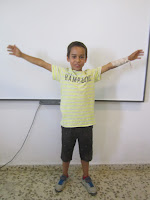To finish the Project, as well as the school year, we've chosen to sing and dance a song that could be a typical summer song to celebrate unity between people and different cultures, happiness, holidays, summer, etc.
We have prepared a choreography which is easy to follow and learn by children, since the gestures are related to the lyrics.
HERE ARE THE LYRICS TO THE SONG:
"El Mismo Sol"
Te digo claro claro
no es nada raro raro
así se puede amor
no es nada raro raro
así se puede amor
Un mundo enano enano
estamos mano a mano
solo hace falta el amor
se puede amor
Yo quiero que este sea el mundo que conteste
del este hasta oeste
y bajo el mismo sol
ahora nos vamos
sí juntos celebramos
aquí todos estamos bajo el mismo sol
Y bajo el mismo sol
Saca lo malo malo
no digas paro paro
vale la pena mí amor, la pena mí amor
no hay fronteras-eras
será lo que tu quieras
lo que tu quieras amor
se puede amor
Yo quiero que este sea el mundo que conteste
del este hasta oeste
y bajo el mismo sol
ahora nos vamos
sí juntos celebramos
aquí todos estamos bajo el mismo sol
Y bajo el mismo sol
Y bajo el mismo sol
Quiero que el mundo se mundo se mundo se
quiero que el mundo se una mí amor
quiero que el mundo se mundo se mundo se
quiero que el mundo se una mí amor na mí amor
Yo quiero que este sea el mundo que conteste
del este hasta oeste
y bajo el mismo sol
ahora nos vamos
sí juntos celebramos
aquí todos estamos bajo el mismo sol
Y bajo el mismo sol
Ahora nos vamos
sí juntos celebramos
aquí todos estamos bajo el mismo sol
bajo el mismo sol, bajo el mismo sol
estamos mano a mano
solo hace falta el amor
se puede amor
Yo quiero que este sea el mundo que conteste
del este hasta oeste
y bajo el mismo sol
ahora nos vamos
sí juntos celebramos
aquí todos estamos bajo el mismo sol
Y bajo el mismo sol
Saca lo malo malo
no digas paro paro
vale la pena mí amor, la pena mí amor
no hay fronteras-eras
será lo que tu quieras
lo que tu quieras amor
se puede amor
Yo quiero que este sea el mundo que conteste
del este hasta oeste
y bajo el mismo sol
ahora nos vamos
sí juntos celebramos
aquí todos estamos bajo el mismo sol
Y bajo el mismo sol
Y bajo el mismo sol
Quiero que el mundo se mundo se mundo se
quiero que el mundo se una mí amor
quiero que el mundo se mundo se mundo se
quiero que el mundo se una mí amor na mí amor
Yo quiero que este sea el mundo que conteste
del este hasta oeste
y bajo el mismo sol
ahora nos vamos
sí juntos celebramos
aquí todos estamos bajo el mismo sol
Y bajo el mismo sol
Ahora nos vamos
sí juntos celebramos
aquí todos estamos bajo el mismo sol
bajo el mismo sol, bajo el mismo sol
These photos show pupils in Y3 rehearsing and doing the steps and gestures to the song:
 |
| I say clearly clearly |
 |
| It is not unusual, weird |
 |
| So we can, love |
 |
| A world dwarf dwarf |
 |
| We are hand by hand |
 |
Only need love
You can, my love
|
 |
| From East to West |
 |
| and under the same sun |
 |
| Now we go |
 |
| Yes, we celebrate together |
 |
| Here we are... |
 |
| all under the same sun. |
 |
| Do not say stop stop |
 |
| it worth worth, my love, my love |
 |
no borders - you were were
will be what you want...
|
...Love, what you want
And... this is the final choreography, performed by Y3C students. :)
Happy summer!!!












































